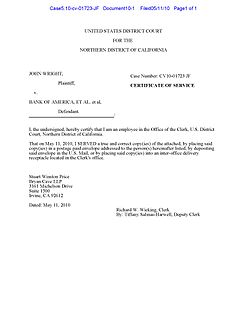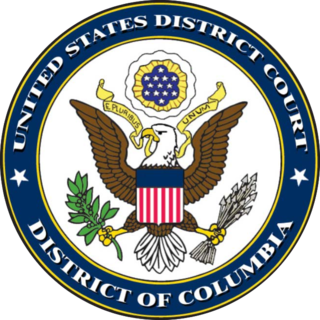In legal terminology, a complaint is any formal legal document that sets out the facts and legal reasons that the filing party or parties believes are sufficient to support a claim against the party or parties against whom the claim is brought that entitles the plaintiff(s) to a remedy. For example, the Federal Rules of Civil Procedure (FRCP) that govern civil litigation in United States courts provide that a civil action is commenced with the filing or service of a pleading called a complaint. Civil court rules in states that have incorporated the Federal Rules of Civil Procedure use the same term for the same pleading.
In law, filing is the delivery of a document to the clerk of a court and the acceptance of the document by the clerk for placement into the official record. If a document is delivered to the clerk and is temporarily placed or deposited with the court, it is said to have been lodged with or received by the court. Courts will not consider motions unless an appropriate memorandum or brief is filed before the appropriate deadline. Usually a filing fee is paid which is part of court costs.
The federal judiciary of the United States is one of the three branches of the federal government of the United States organized under the United States Constitution and laws of the federal government. The U.S. federal judiciary consists primarily of the U.S. Supreme Court, the U.S. Courts of Appeals, and the U.S. District Courts. It also includes a variety of other lesser federal tribunals.
The Electronic Filing System is the Singapore Judiciary's electronic platform for filing and service of documents within the litigation process. In addition, it provides the registries of the Supreme Court and the Subordinate Courts with an electronic registry and workflow system; and an electronic case file. Recent enhancements have added a module which facilitates the conduct of hearing using documents that have been electronically filed.
PACER is an electronic public access service for United States federal court documents. It allows users to obtain case and docket information from the United States district courts, United States courts of appeals, and United States bankruptcy courts. The system is managed by the Administrative Office of the United States Courts in accordance with the policies of the Judicial Conference, headed by the Chief Justice of the United States. As of 2013, it holds more than 500 million documents.
Electronic discovery refers to discovery in legal proceedings such as litigation, government investigations, or Freedom of Information Act requests, where the information sought is in electronic format. Electronic discovery is subject to rules of civil procedure and agreed-upon processes, often involving review for privilege and relevance before data are turned over to the requesting party.
A docket in the United States is the official summary of proceedings in a court of law. In the United Kingdom in modern times it is an official document relating to delivery of something, with similar meanings to these two elsewhere. In the late nineteenth century the term referred to a large folio book in which clerks recorded all filings and court proceedings for each case, although use has been documented since 1485.
Electronic Case Filing System (ECFS) is an automated system developed in Tarrant County, Texas that enables law enforcement agencies, criminal district attorney, county criminal courts, criminal district courts, and the defense bar to process and exchange information about criminal offenses. ECFS software does not work on the Apple Mac platform.

A data breach is a security violation, in which sensitive, protected or confidential data is copied, transmitted, viewed, stolen or used by an individual unauthorized to do so. Other terms are unintentional information disclosure, data leak, information leakage and data spill. Incidents range from concerted attacks by individuals who hack for personal gain or malice, organized crime, political activists or national governments, to poorly configured system security or careless disposal of used computer equipment or data storage media. Leaked information can range from matters compromising national security, to information on actions which a government or official considers embarrassing and wants to conceal. A deliberate data breach by a person privy to the information, typically for political purposes, is more often described as a "leak".

In re Boucher, is a federal criminal case in Vermont, which was the first to directly address the question of whether investigators can compel a suspect to reveal their encryption passphrase or password, despite the U.S. Constitution's Fifth Amendment protection against self-incrimination. A magistrate judge held that producing the passphrase would constitute self-incrimination. In its submission on appeal to the District Court, the Government stated that it does not seek the password for the encrypted hard drive, but only sought to force Boucher to produce the contents of his encrypted hard drive in an unencrypted format by opening the drive before the grand jury. A District Court judge agreed with the government, holding that, given Boucher's initial cooperation in showing some of the content of his computer to border agents, producing the complete contents would not constitute self-incrimination.
Pro se legal representation comes from Latin pro se, meaning "for oneself" or "on behalf of themselves" which, in modern law, means to argue on one's own behalf in a legal proceeding, as a defendant or plaintiff in civil cases, or a defendant in criminal cases, rather than have representation from counsel or an attorney.

Public.Resource.Org (PRO) is a 501(c)(3) non-profit corporation dedicated to publishing and sharing public domain materials in the United States and internationally. It was founded by Carl Malamud and is based in Sebastopol, California.

A notice of electronic filing (NEF) is part of the system established by the Administrative Office of the United States Courts through the docketing and access systems of PACER & CM/ECF. PACER is a public-access system accessible by any person after registration and for a fee. CM/ECF is the Case Management/Electronic Court Filing system, available only to those admitted to a particular U.S. District or U.S. Court of Appeals. The NEF provides a record of service of an electronically filed document by parties, or of service of the electronically filed orders and judgments of the courts, upon attorneys in the case and the court. For such parties, the NEF has replaced the traditional service via US Mail or other "paper" methods.
The California Court Case Management System (CCMS) is the court case management system intended for use by the several courts of the judiciary of California, which includes the Supreme Court, 6 Courts of Appeal, and 58 Superior Courts.
RECAP is software which allows users to automatically search for free copies of documents during a search in the fee-based online U.S. federal court document database PACER, and to help build up a free alternative database. It was created in 2009 by a team from Princeton University's Center for Information Technology Policy and Harvard University's Berkman Center, and is now maintained as part of the Free Law Project. The name "RECAP" derives from "PACER", spelled backward.

Joffe v. Google, Inc. is a federal lawsuit between Ben Joffe and Google, Inc. Joffe claimed that Google broke one of the Wiretap Act segments when they intruded on the seemingly "public" wireless networks of private homes through their Street View application. Although Google tried to appeal their case multiple times, the courts favored Joffe's argument. Ultimately the Supreme Court declined to take the case, affirming the decision by the United States Court of Appeals for the Ninth Circuit that the Wiretap Act covers the interception of unencrypted Wi-Fi communications.
MassCourts is the case management system used in the Massachusetts court system.

Citizens for Responsibility and Ethics in Washington and National Security Archive v. Trump and EOP, No. 1:17-cv-01228, is a case pending before the United States District Court for the District of Columbia. The plaintiffs, the watchdog group Citizens for Responsibility and Ethics in Washington (CREW) and the archivist National Security Archive, allege that the defendants, President Donald Trump and elements of the Executive Office of the President, are in violation of the Presidential Records Act by deleting electronic messages on Twitter and using other electronic messaging applications without required archival records.

In 2020, a major cyberattack suspected to have been committed by a group backed by the Russian government penetrated thousands of organizations globally including multiple parts of the United States federal government, leading to a series of data breaches. The cyberattack and data breach were reported to be among the worst cyber-espionage incidents ever suffered by the U.S., due to the sensitivity and high profile of the targets and the long duration in which the hackers had access. Within days of its discovery, at least 200 organizations around the world had been reported to be affected by the attack, and some of these may also have suffered data breaches. Affected organizations worldwide included NATO, the U.K. government, the European Parliament, Microsoft and others.
Berserk Bear is a Russian cyber espionage group, sometimes known as an advanced persistent threat. According to the United States, the group is composed of "FSB hackers," either those directly employed by the FSB or Russian civilian, criminal hackers coerced into contracting as FSB hackers while still freelancing or moonlighting as criminal hackers. Four accused Berserk Bear participants, three FSB staff and one civilian, have been indicted in the United States and are regarded by the United States Department of Justice as fugitives.







